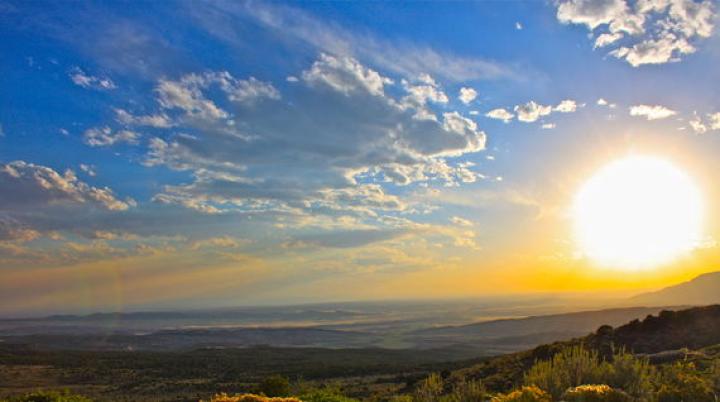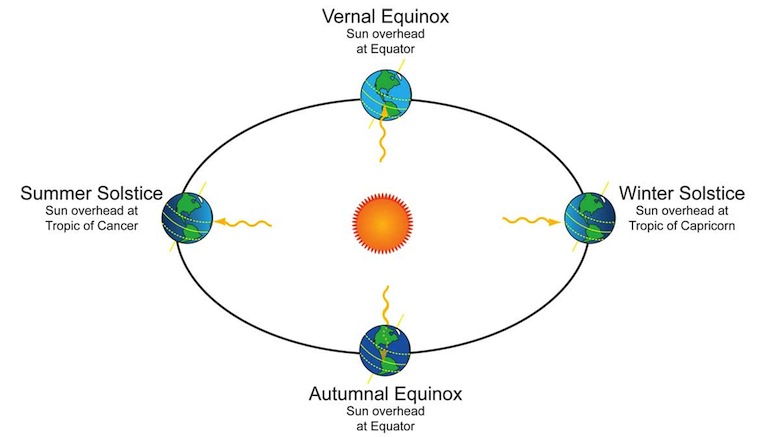
When is the Summer Solstice?
 |
| Jeannine Jones (almanac.com) |
The timing of the solstice depends on when the Sun reaches its northernmost point of the equator.
What is it?
What is it?
The word solstice is from the Latin solstitium, from Sol (sun) and stitium (to stop, hold still), reflecting the fact that the Sun appears to stop at this time (and again at the winter solstice).
In temperate regions, we notice that the Sun is higher in the sky throughout the day, and its rays strike Earth at a more direct angle, causing the efficient warming we call summer.
In temperate regions, we notice that the Sun is higher in the sky throughout the day, and its rays strike Earth at a more direct angle, causing the efficient warming we call summer.
- Editor of The Old Farmer’s Almanac Janice Stillman dives into the Almanac’s archives to explore the importance of the solstice as a seasonal celebration in cultures across the world and throughout history. Go to Slooh.com to watch the live broadcast, snap, and share photos during the event, chat with audience members, interact with the hosts, and personally control Slooh’s telescopes. See also Bob Berman’s Solstice Full Moon here.
This summer solstice is the day with the most hours of sunlight during the whole year. See handy sunrise and sunset calculator for how many hours of sunlight in every location.
At the winter solstice, just the opposite occurs: The Sun is at its southernmost point and is low in the sky. Its rays hit the Northern Hemisphere at an oblique angle, creating the feeble winter sunlight.

Why doesn’t Summer Solstice fall on same date?
The summer solstice in the Northern Hemisphere ranges in date from June 20 to 22. This occurs in part because of the difference between the Gregorian calendar system, which normally has 365 days, and the tropical year (how long it takes Earth to orbit the Sun once), which has about 365.242199 days.
To compensate for the missing fraction of days, the Gregorian calendar adds a leap day about every 4 years, which makes the date for summer jump backward. However, the date also changes because of other influences, such as the gravitational pull from the Moon and planets and the slight wobble in Earth’s rotation.
Did You Know?
To compensate for the missing fraction of days, the Gregorian calendar adds a leap day about every 4 years, which makes the date for summer jump backward. However, the date also changes because of other influences, such as the gravitational pull from the Moon and planets and the slight wobble in Earth’s rotation.
Did You Know?
Question: Why isn’t the summer solstice, the longest day of the year, also the hottest day of the year?
Answer: Earth’s atmosphere, land, and oceans absorb part of the incoming energy from the Sun and store it, releasing it back as heat at various rates. [By coincidence in California, these two days will coincide this year with temps over 100 as happens in late summer.]
Water is slower to heat (or cool) than air or land. At the summer solstice, the Northern Hemisphere receives the most energy (highest intensity) from the Sun due to the angle of sunlight and day length.
However, the land and oceans are still relatively cool, due to spring’s temperatures, so the maximum heating effect on air temperature is not felt just yet. Eventually, the land and, especially, oceans will release stored heat from the summer solstice back into the atmosphere.
This usually results in the year’s hottest temperatures appearing in late July, August, or later, depending on latitude and other factors. This effect is called seasonal temperature lag.
Water is slower to heat (or cool) than air or land. At the summer solstice, the Northern Hemisphere receives the most energy (highest intensity) from the Sun due to the angle of sunlight and day length.
However, the land and oceans are still relatively cool, due to spring’s temperatures, so the maximum heating effect on air temperature is not felt just yet. Eventually, the land and, especially, oceans will release stored heat from the summer solstice back into the atmosphere.
This usually results in the year’s hottest temperatures appearing in late July, August, or later, depending on latitude and other factors. This effect is called seasonal temperature lag.
Question: What is Midsummer Day (June 24)?
Answer: Around the time of the summer solstice, this day was the midpoint of the growing season, halfway between planting and harvest. Read more about the ancient Quarter Days!
Seasons on Other Planets
Seasons on Other Planets
- Mercury has virtually no tilt (less than ⅓0th of a degree) relative to the plane of its orbit, and therefore does not experience true seasons.
- Uranus is tilted by almost 98 degrees and has seasons that last 21 years.
Fun Facts
In Sweden, people celebrate the Summer Solstice by eating the first strawberries of the season.
In ancient Egypt, summer was the start of the new year. The rising of the star Sirius roughly coincided with the summer solstice and the annual flooding of the Nile River.
Watch it LIVE
Watch it LIVE
Watch the LIVE Summer Solstice Full Moon at almanac.com. This June, 2016, the solstice and full Moon coincide—a rare event, indeed. Monday, June 20, at 8:00 PM EDT, 5:00 PM PDT, 00:00 UTC (See your time zone).
Join The Old Farmer’s Almanac and Slooh -- from Slooh’s flagship observatory at the Institute of Astrophysics in the Canary Islands -- to witness the rare event as the Full Moon rises on the same day as the Summer Solstice, an event which hasn’t occurred for nearly 70 years.
Join The Old Farmer’s Almanac and Slooh -- from Slooh’s flagship observatory at the Institute of Astrophysics in the Canary Islands -- to witness the rare event as the Full Moon rises on the same day as the Summer Solstice, an event which hasn’t occurred for nearly 70 years.
During
the broadcast, Slooh Host Paul Cox will be joined by
Almanac astronomer Bob Berman to discuss this rare astronomical
combination, including why it’s been so long since the last one, when
such a combination is mathematically predicted to happen every 15
years.
“Having a full moon land smack on the solstice is a truly rare event,” says Berman.
“We probably won’t push people off pyramids like the Mayans [allegedly] did, but Slooh will very much celebrate this extraordinary day of light with fascinating factoids and amazing live telescope feeds.” The Summer Solstice Full Moon show is on Monday, June 20! More
“Having a full moon land smack on the solstice is a truly rare event,” says Berman.
“We probably won’t push people off pyramids like the Mayans [allegedly] did, but Slooh will very much celebrate this extraordinary day of light with fascinating factoids and amazing live telescope feeds.” The Summer Solstice Full Moon show is on Monday, June 20! More



















































































































































































































































No comments:
Post a Comment